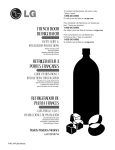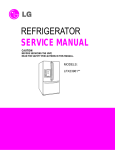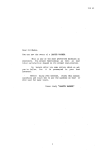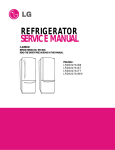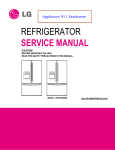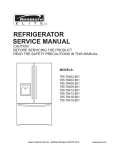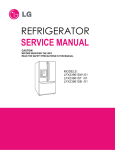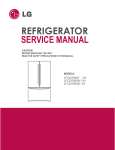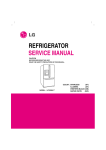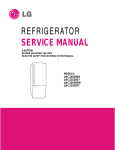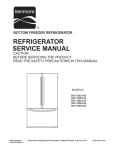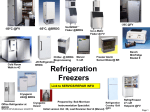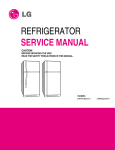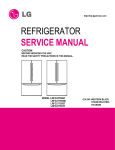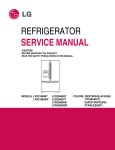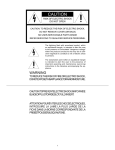Download REFRIGERATOR SERVICE MANUAL
Transcript
REFRIGERATOR SERVICE MANUAL CAUTION BEFORE SERVICING THE PRODUCT, READ THE SAFETY PRECAUTIONS IN THIS MANUAL. MODELS: LBC20514TT CONTENTS Safety Precautions………………………………………………................................ 2 1- Specifications…………………………………………………................................ 3 2- Parts Identifications …………………………………………................................ 4 3- Disassembly……………………………………………………............................... 5 Door……………………………………………………………................................... 5 Door Switch……………………………………………………...................................5 Fan and Fan Motor……………………………………………..................................6 Defrost Control Assembly ……………………………………..................................6 Lamp……………………………………………………………..................................6 Refrigerator Control Box……………………………………….................................6 Multi Duct……………………………………………………….................................. 6 4- Ajustment…………………………………………………….................................... 7 Compressor…………………………………………………….................................. 7 PTC-Starter…………………………………………………….................................. 7 OLP (Overload Protector)…………………………………….................................. 8 To Remove the Cover PTC………………………………….................................. 8 5- Circuit Diagram……………………………………………..................................... 9 6- Troubleshooting……………………………………...................................……….10 Compressor and Electric Components…………………....................................…10 PTC and OLP …………………………………………....................................…….11 Other Electrical Components………………………….....................................……12 Service Diagnosis Chart……………………………....................................………13 Refrigeration Cycle…….………………………………....................................……14 7- Operation Principle and Repair Method of Ice Maker….................................16 8- Description of Function and Circuit of MICOM……….............................……19 11- Refrigerator Exploded View …....................................................................... 38 SAFETY PRECAUTIONS Pleasereadthefollowinginstructionsbeforeservicingyour refrigerator. 1.Checktherefrigeratorforcurrentleakage. 2.Topreventelectricshock,unplugbeforeservicing. 3.Alwayschecklinevoltageandamperage. 4.Usestandardelectricalcomponents. 5.Don'ttouchmetalproductsinthefreezerwithwet hands.Thismaycausefrostbite. 6.Preventwaterfromspilingontoelectricelementsorthe machineparts. 7.Beforetiltingtherefrigerator,removeallmaterialsfrom onorintherefrigerator . 8.Whenservicingtheevaporato,rwearglovestoprevent injuriesfromthesharpevaporatorfins. 9.Serviceontherefrigeratorshouldbeperformedbya qualifiedtechnician.Sealedsystemrepairmustbe performedbyaCFCcertifiedtechnician. -2- 1. SPECIFICATIONS Models Color Capacity Dimensions (in) Refrigerant Climate Class Control Type Rating Case Material Specification Door Material Reversible Door Lamp (F) Lamp ( R ) Basket (F) Basket ( R ) Shelf (F) Shelf ( R ) Cover, TV Drawer Vegetable Tray Meat Multi Flow LBC20514TT Titanium 20cuft 29.8 (W) x 32.2 (D) x 67.9 (H) R134A (4.2oz) Temperate(N) F-control 115/60 EMBO(Normal) VCM Yes 1 (40W/Blue) 2 (40W/Blue) 1 (plastic) 2 (1/3) 2 (2/3) 1 full 1 Wire 4 fix Humidity Control Wire (lower) Yes Yes Yes -3- 2. PARTS IDENTIFICATIONS PARTSANDFEATURES A B I C J D K E L F M G H N Use this section to become more familiar with the parts and features. NOTE:This guide covers several different models.The refrigerator you have purchased may have some or all of the items listed below.The locations of the features shown below may not match your model. A Digital Sensor Control I Dairy Bin B Refrigerator Light J Design-A-Door C Shelves K Wire Freezer Shelf D Snack Pan L Refrigerator Door Rack E Optibin Crisper Keeps fruits and vegetable fresh and crisp M Freezer Light N Freezer Door Rack F Ice Tray* *on some models G Ice Bin H Wire Durabase -4- 3. DISASSEMBLY 3-1 DOOR Refrigerator Door 1. Remove the hinge cover by pulling it upwards. 2. Loosen the hexagonal bolts attaching the upper hinge to the body and lift the freezer door. Freezer Door 1. Loosen the hexagonal bolts attaching the lower hinge to the body to remove the refrigerator door only. LOWER HINGE HINGE COVER BOLT BOLT HINGE Figure 3 Figure 1 3. Pull out the door gasket to remove from the door foam assembly. 2. Pull out the door gasket to remove from the door foam assembly. 3-2 DOOR SWITCH GASKET 1. To remove the door switch, pry it out with a slotted-type driver, as shown in (Figure 4). 2. Disconnect the lead wire from the switch. LEAD WIRE DOOR SWITCH Figure 4 Figure 2 -5- 3-3 FAN AND FAN MOTOR 1. Remove the freezer shelf. (If your refrigerator has an icemaker, remove the icemaker first) 2. Remove the grille by pulling it out and by loosening a screw. 3. Remove the Fan Motor assembly by loosening 2 screws and disassemble the shroud. 4. Pull out the fan and separate the Fan Motor and Bracket. 5. Pull out the fan and separate the Fan Motor and Bracket. 3-5-1 Refrigerator Compartment Lamp 1. Unplug the power cord from the outlet. 2. Remove refrigerator shelves. 3. Release the hooks on both ends of the lamp shield and pull the shield downward to remove it. 4. Turn the lamp counterclockwise. 5. Assemble in reverse order of disassembly. Replacement bulb must be the same specification as the original (Max. 60 W-2EA). FAN MOTOR BRACKET MOTOR Figure 9 FAN 3-5-2 Freezer Compartment Lamp Figure 11 GRILLE 3-6 CONTROL BOX-REFRIGERATOR 3-4 DEFROST CONTROL ASSEMBLY Defrost Control assembly consists of Defrost Sensor and FUSE–M. The Defrost Sensor works to defrost automatically. It is attached to the metal side of the Evaporator and senses its Temperature. Fuse-M is a safety device for preventing over-heating of the Heater when defrosting. At 72°C, it turns the Defrost Heater off. 1. Pull out the grille assembly. (Figure 6) 2. Separate the connector with the Defrost Control assembly and replace the Defrost Control assembly after cutting the Tie Wrap. (Figure 7) GRILLE ASSEMBLY 1. Unplug refrigerator or disconnect power. 2. Reach behind light shield to remove bulb. 3. Replace bulb with a 60-watt appliance bulb. 4. Plug in refrigerator or reconnect power. DEFROST-CONTROL ASSEMBLY 1. First, remove all shelves in the refrigerator, than remove the Refrigerator control Box by loosening 2 screws. CONTROL BOX COVER LAMP Figure 10 2. Remove the Refrigerator Control Box by pulling it downward. 3. Disconnect the lead wire on the right position and separate the lamp sockets. 3-7 MULTI DUCT Figure 6 Figure 7 3-5 LAMP 1. Remove an upper and lower Cap by using a flat screwdriver, and loosen 3 screws. (Figure 11) 2. Disconnect the lead wire on the bottom position. Figure 11 Figure 8 -6- 4. ADJUSTMENT 4-1 COMPRESSOR 4-1-1 Role 4-2-3 PTC-Applied Circuit Diagram Starting Method for the Motor The compressor intakes low temperature and low pressure gas from the evaporator of the refrigerator and compresses this gas to high-temperature and high-pressure gas. It then delivers the gas to the condenser. OVERLOAD PROTECTOR N 4-1-2 Composition The compressor includes overload protection. The PTC starter and OLP (overload protector) are attached to the outside of the compressor. Since the compressor is manufactured to tolerances of 1 micron and is hermetically sealed in a dust and moisture-free environment, use extreme caution when repairing it. 4-1-3 Note for Usage (1) Be careful not to allow over-voltage and over-current. (2) If compressor is dropped or handled carelessly, poor operation and noise may result. (3) Use proper electric components appropriate to the Particular Compressor in your product. (4) Keep Compressor dry. If the Compressor gets wet (in the rain or a damp environment) and rust forms in the pin of the Hermetic Terminal, poor operation and contact may result. (5) When replacing the Compressor, be careful that dust, humidity, and soldering flux don’t contaminate the inside of the compressor. Dust, humidity, and solder flux contaminate the cylinder and may cause noise, improper operation or even cause it to lock up. 4-2 PTC-STARTER 4-2-1 Composition of PTC-Starter (1) PTC (Positive Temperature Coefficient) is a no-contact semiconductor starting device which uses ceramic material consisting of BaTiO3. (2) The higher the temperature is, the higher the resistance value. These features are used as a starting device for the Motor. 4-2-2 Role of PTC-Starter (1) The PTC is attached to the Sealed Compressor and is used for starting the Motor. (2) The compressor is a single-phase induction motor. Durign the starting operation, the PTC allows current flow to both the start winding and main winding. C 2 PTC 5 S L1 3 6 PTC STARTER Resistance Starter Capacitor Running COMPRESSOR MOTOR M M S SEALED TERMINAL Figure 12 4-2-4 Motor Restarting and PTC Cooling (1) It requires approximately 5 minutes for the pressure to equalize before the compressor can restart. (2) The PTC device generates heat during operation. Therefore, it must be allowed to cool before the compressor can restart. 4-2-5 Relation of PTC-Starter and OLP (1) If the compressor attempts to restart before the PTC device is cooled, the PTC device will allow current to flow only to the main winding. (2) The OLP will open because of the over current condition. This same process will continue (3 to 5 times) when the compressor attempts to restart until the PTC device has cooled. The correct OLP must be properly attached to prevent damage to the compressor. Parts may appear physically identical but could have different electrical ratings. Replace parts by part number and model number. Using an incorrect part could result in damage to the product, fire, injury, or possibly death. 4-2-6 Note for Using the PTC-Starter (1) Be careful not to allow over-voltage and over-current. (2) Do not drop or handle carelessly. (3) Keep away from any liquid. If liquid such as oil or water enters the PTC, PTC materials may fail due to breakdown of their insulating capabilities. (4) If the exterior of the PTC is damaged, the resistance value may be altered. This can cause damage to the compressor and result in a no-start or hard-to-start condition. (5) Always use the PTC designed for the compressor and make sure it is properly attached to the compressor. Parts may appear physically identical but could have different electrical ratings. Replace parts by part number and model number. Using an incorrect part could result in damage to the product, fire, injury, or possibly death. -7- 4-3 OLP (OVERLOAD PROTECTOR) 4-4 TO REMOVE THE COVER PTC 4-3-1 Definition of OLP (1) OLP (OVERLOAD PROTECTOR) is attached to the Compressor and protects the Motor by opening the circuit to the Motor if the temperature rises and activating the bimetal spring in the OLP. (2) When high current flows to the Compressor motor, the Bimetal works by heating the heater inside the OLP, and the OLP protects the Motor by cutting off the current flowing to the Compressor Motor. 4-3-2 Role of the OLP (1) The OLP is attached to the Sealed Compressor used for the Refrigerator. It prevents the Motor Coil from being started in the Compressor. (2) For normal operation of the OLP, do not turn the Adjust Screw of the OLP in any way. 1) Remove the Cover Back M/C. (2) Remove the screw on Cover PTC. (OVERLOAD PROTECTOR cross section) 12345678 330 FBYY Electrical characteristics part number -S1 BOX98 Customer part number Lot code/ date code Physical termination part number Part No. Name Base, phenolic (UL 94 V-0 rated) Movable arm support, plated steel Stationary contact support, plated steel Heater support, plated steel Heater, resistance alloy Disc, thermostatic alloy Movable arm, spring temper copper alloy Contact, movable, silver on copper Contact, stationary, silver on copper Slug, plated steel Cover, polyester (UL 94 V-0 rated) Pin connector, plated copper alloy (To engage 2.33/2.66 mm dia. pin) Quick-connect terminal, brass, conforms to UL 310, MEMA DC-2, DIN 46344 Figure 13 1 (3) Remove two Housings on upper part of Cover PTC. (4) Take out the cover PTC from upper to lower position like ( 1 ). 2 (5) Turn 45¡ in the direction of (2)and take it out. (6) Assembly in reverse order of disassembly. -8- 5. CIRCUIT DIAGRAM PWB(PCB) ASSEMBLY,DISPLAY BO BL /WH SB PR BK PK WH YL STEPPING MOTOR F-FAN PERCEPTION S/W 1 2 3 4 5 6 7 8 9 WH /RD R-DOOR CON101 C D WH /RD PR GY WH BL BK YL RD BO BL /WH SB PR BK PK WH 1 2 3 4 5 6 7 8 9 10 11 12 13 1 2 CON4 YL GY GY 3 4 5 6 7 8 9 10 11 12 CON5 PWB(PCB) ASSEMBLY, MAIN CON6 L1 11 10 9 8 7 6 5 4 3 2 1 BL YL BL BK SB BN POWER SUPPLY CORD 1 2 3 4 5 6 7 8 PK PK BO BO A F-DOOR B PERCEPTION S/W DEF-SENSOR WH R-SENSOR WH BL F-SENSOR BL 7 6 5 4 3 2 1 RD SB BN CON1 CON2 SB YL BN BL BL BK BN RD SB N Cs 4 S 5 GN /YL 1 RD CON6 2 BL 1 BK CON1 2 BK 1 WH CON2 1 WH CON3 1 WH 2 WH 1 WH CON4 CON5 M 3 BL PWB (PCB) ASSEMBLY, ICE MAKER 6 (GN) PTC STARTER BL BL com com nc nc com DOOR S/W-R com BO PR R-LAMPS 2 RD C D A B F-LAMP M RD C-FAN I/MAKER W/VALVE V OLP PK nc FUSE-M (72 C) (98 C) BK FUSE-M CAPACITOR PART Cr POWER S/W M ICE MAKER MOTOR HEATER, SHEATH ICE SENSOR GN/YL (GN) nc BK BK ICE MAKER PART HEATER,SHEATH GN/YL (GN) DOOR S/W-F L BL BL COMP' EARTH PART COMP' ACCESSORIES * ALTERNATIVE COMP' ACCESSORIES * P.T.C START OPTION MC,MQ COMP' Cr BL OLP *PLUG TYPE, ICE MAKER PART, CAPACITOR PART, P.T.C START OPTION, COMP' EARTH PART AND COMP' ACCESSORIES ON CIRCUIT DIAGRAM ARE SUBJECT TO CHANGE IN DIFFERENT LOCALITIES AND MODEL TYPE. BK N EG COMP' 3 2 L 4 5 4 6 3 6 2 5 PTC COMBO KIT(PTC+OLP) BK:BLACK YL:YELLOW WH:WHITE PK:PINK BN:BROWN GN:GREEN BO:BRIGHT ORANGE PR:PURPLE -9- MEZ48108403 SB:SKY BLUE GY:GREY RD:RED BL:BLUE 6. TROUBLESHOOTING 6-1 COMPRESSOR AND ELECTRIC COMPONENTS 1 Power Source. YES Remove PTC-Starter from compressor and measure voltage between Terminal C of compressor and terminal 5 or 6 of PTC. (Rated voltage ±10%)? No voltage. OLP disconnected? 2 YES Replace OLP. NO 5 Check connection condition. Reconnect. Applied voltage isn't in acceptable range. (115V ±10%) 2 Check Check resistance resistance of of motor motor compressor. compressor. . Advise customer that power supply needs to be checked by an electrician. 5 The range of resistance is between 1~50 ? (ok) Check the resistance between M-C, S-C and Replace M-S in motor compressor. Open or short compressor 3 Check resistance of PTC-Starter. Check resistance of two terminals in PTC-Starter. Refer to Page 12. 4 Check OLP. Check resistance of two terminals in OLP. Refer to Page 12. 5 Check starting state. Check the power supply under load. (Compressor attempting to re-start after being off for 5 minutes). Supply voltage rating with ±10%. YES 3 Did compressor start? 4 YES NO NO - 10 - 3 5 Compressor is OK Replace the compressor 1 6-2 PTC AND OLP Separate PTC-Starter from Compressor and measure resistance between No. 5 and 6 of PTC-Starter with a Tester. (Figure 19) Observation value is 115V/60Hz : 6.8 ? ±30% The resistance value is 0 ? (short) or 8(open). Separate OLP from compressor and check resistance value between two terminals of OLP whit a tester. (Figure 20) Shows continuity Open Check another electric component. Replace OLP. 5 6 Normal operation of compressor is impossible or poor. ? Figure 19 - 11 - Figure 20 Replace PTCStarter. 6-3 OTHER ELECTRICAL COMPONENTS Not cooling at all Compressor doesn't run. Check for open short or incorrect resistance readings in the following components Cause a. Starting devices Short, open, or broken. b. OLP Poor contact or shorted. c. Compressor coil Coil open or shorted. d.Wiring harness Poor contact or shorted. Replace indicated component. Poor cooling performance Compressor runs poorly. Check starting voltage. Low voltage. Advise customer that the power supply needs to be checked by an electrician. Fan motor doesn't run. Check voltage at starting devices. Poor or broken or open contact. Check current flowing in sub-coil of Compressor. Shorted. Check rating of OLP. Lack of capacity. Check wiring circuit. Wire is open or shorted. Replace indicated component. Coil is shorted or open. Check Fan Motor. Heavy frost buildup on evaporator Replace indicated component. Check current flow in the following components: Sensor Fuse-M Check current flow in the defrost heater. - 12 - Open. Replace indicated component. Open. Replace defrost heater. 6-4 SERVICE DIAGNOSIS CHART COMPLAINT POINTS TO BE CHECKED REMEDY No Cooling. • Is the power cord unplugged from the outlet? • Check if the power switch is set to OFF. • Check if the fuse of the power switch is shorted. • Measure the voltage of the power outlet. • Plug into the outlet. • Set the switch to ON. • Replace the fuse. • If the voltage is low, correct the wiring. Cools poorly. • Check if the unit is placed too close to the wall. • Check if the unit is placed too close to the stove, gas cooker, or in direct sunlight. • Is the ambient temperature too high or the room door closed? • Check if food put in the refrigerator is hot. • Did you open the door of the unit too often or check if the door is sealed properly? • Check if the Control is set to Warm position. • Place the unit about 4 inches (10 cm) from the wall. • Place the unit away from these heat sources. • Is food placed in the cooling air outlet? • Check if the control is set to colder position. • Is the ambient temperature below 41°F(5° C)? • Place foods in the high-temperature section. (front part) • Set the control to Recommended position. • Set the control to Warm position. Condensartion or ice forms inside the unit. • Is liquid food sealed? • Check if food put in the refrigerator is hot. • Did you open the door of the unit too often or check if the door is sealed properly? • Seal liquid foods with wrap. • Put in foods after they have cooled down. • Don't open the door too often and close it firmly. Condensartion forms in the Exterior Case. • Check if the ambient temperature and humidity of the surrounding air are high. • Is there a gap in the door gasket? • Wipe moisture with a dry cloth. It will disappear in low temperature and humidity. • Fill up the gap. There is abnormal noise. • Is the unit positioned in a firm and even place? • Adjust the Leveling Screw, and position the refrigerator in a firm place. • Remove the objects. Foods in the Refrigerator are frozen. Door does not close well. • Are any unnecessary objects placed in the back side of the unit? • Check if the Tray Drip is not firmly fixed. • Check if the cover of the compressor enclosure in the front lower side is taken out. • Check if the door gasket is dirty with an item like juice. • Is the refrigerator level? • Put in foods after they have cooled down. • Don't open the door too often and close it firmly. • Set the control to Recommended position. • Fix the Tray Drip firmly in the original position. • Place the cover in its original position. • Clean the door gasket. • Is there too much food in the refrigerator? Ice and foods smell unpleasant. • Lower the ambient temperature. • Check if the inside of the unit is dirty. • Are foods with a strong odor unwrapped? • The unit smells of plastic. • Position in the firm place and level the Leveling Screw. • Make sure food stored in shelves does not prevent the door from closing. • Clean the inside of the unit. • Wrap foods that have a strong odor. • New products smell of plastic, but this will go away after 1-2 weeks. Other possible problems: Check if frost forms in the freezer. Not defrosting Check Components of the defrosting circuit. Check the refrigeration system. The system is faulty. Perform sealed system repair. Check the Thermistor. The operation of the Thermistor is incorrect. - 13 - Replace the Thermistor. 6-5 REFRIGERATION CYCLE * Troubleshooting Chart CAUSE STATE OF THE UNIT STATE OF THE EVAPORATOR TEMPERATURE OF THE COMPRESSOR REMARKS A little higher than ambient temperature. - Refrigerant level is low due to a leak. ¥ - Normal cooling is possible by restoring the normal amount of ¥ refrigerant and repairing the leak. ¥ Equal to ambient temperature. - No discharging of refrigerant. - Normal cooling is possible by restoring the normal amount of ¥ refrigerant and repairing the leak. ¥ A little higher than ambient temperature. - Normal discharging of the refrigerant. ¥ - The capillary tube is faulty. Freezer compartment and refrigerator don’t cool normally Low flowing sound of refrigerant is heard and frost forms in inlet only. COMPLETE LEAKAGE Freezer compartment and refrigerator don’t cool normally Flowing sound of refrigerant is not heard and frost isn’t formed. PARTIAL CLOG Freezer compartment and refrigerator don’t cool normally Flowing sound of refrigerant is heard and frost forms in inlet only. WHOLE CLOG Freezer compartment and refrigerator don’t cool. Flowing sound of refrigerant is Equal to ambient not heard and frost isn’t temperature. formed. MOISTURE CLOG Cooling operation stops periodically. Flowing sound of refrigerant is Lower than ambient - Cooling operation restarts when heating the inlet of the capillary ¥ not heard and frost melts. temperature. tube. ¥ PARTIAL LEAKAGE LEAKAGE CLOGGEDBYDUST DEFECTIVE COMPRESSION Alittle higher than ambient temperature. COMPRE- Freezer and refrigerator don’t SSION Low flowing sound of refrigerant is heard and frost forms in inlet only. NO COMPRESSION Flowing sound of refrigernat is Equal to ambient temperature not heard and there is no frost. cool. No compressing operation. - 14 - - Normal discharging of the refrigerant. ¥ - Low pressure at high side of compressor due to low ¥ refrigerant level. ¥ - Nopressure in the high pressure part ¥ of the compressor. ¥ 6-5-1 SEALED SYSTEM DIAGNOSIS Not Cooling Complaint All components operating, No airflow problems, Not frosted up as a defrost problem problem has been isolated to sealed system area Frost Pattern? Partial None Equalization Test Equalization Test Very Fast Very Slow Very Slow Very Fast Fast Inefficient Compressor Partial Restriction Complete Restriction Condenser Temperature Cap Tube Sound Hotter than Normal Faint Room Temperature None to Weak Air/Low Side Leak Loss of Change Compressor Not Pumping Trace of Oil Yes No Leak Undercharge (The equalization test is trying to restart a compressor after it has been operating.) - 15 - 7. OPERATION PRINCIPLE AND REPAIR METHOD OF ICE MAKER 7-1 OPERATION PRINCIPLE 7-1-1 Operation Principle of Ice Maker Power On Start Position Icemaking Mode Harvest Mode Fill Park Position Test Mode Adjusts Ejector to Start Position with power on. • Waits until water becomes cold after starting the Icemaking operation. • Runs MOTOR to drop ice from the tray into the ICE BIN. • Performs Icemaking Mode after supplying water by operating the SOLENOID in ICE VALVE. • With the detect lever, checks if the ICE BIN is full. • To operate LINE and SERVICE, press and hold the Cube Size button for 3 seconds. The icemaking will run through 3 stages: Harvest Fill Icemaking. 1. Turning the Icemaker stop switch off (O) stops the icemaking function. 2. Setting the Icemaker switch to OFF and then turning it back on will reset the icemaker control. Cube Size button Power (On/Off) Switch - 16 - 7-2 ICE MAKER FUNCTIONS 7-2-1 Ice Making Mode 1. Icemaking refers to the freezing of supplied water in the ice trays. Complete freezing is assured by measuring the temperature of the Tray with icemaking SENSOR. 2. Icemaking starts after completion of the water fill operation. 3. The icemaking function is completed when the sensor reaches -7°C, 60 to 240 minutes after starting. NOTE : After icemaker power is ON, the icemaker heater will be on for test for 9 sec. 7-2-2 Harvest Mode 1. Harvest (Ice removing) refers to the operation of dropping ices into the ice bin from the tray when icemaking has completed. 2. Harvest mode: (1) The Heater is ON for 30 seconds, then the motor starts. (2) Harvest mode is completed if it reaches start position again while Heater & Motor are on at the same time. A. ice bin is full : The EJECTOR stops (heater off). B. ice bin is not full : The EJECTOR rotates twice to open for ice. NOTE : If the EJECTOR does not rotate once within 5 minutes in status (2), separate heater control mode starts operating to prevent the EJECTOR from being constrained. (It is recommended that the user open for ice to return to normal mode.) 7-2-3 Fill/Park Position 1. Once a normal harvest mode has been completed, the water solenoid will be activated. 2. The amount of water is adjusted by pressing the fill key repeatedly. This changes the time allowed for fill as illustrated in the table below. Water supply amount table STAGE TIME TO SUPPLY 1 6 sec. INDICATIONS REMARKS The water amount will vary depending 2 on the water control switch setting, as 7 sec. well as the water pressure of the connected water line. 3 8 sec. - 17 - 7-2-5 Function TEST 1. This is a compulsory operation for test, service, cleaning, etc. It is operated by pressing and holding the Cube Size button for 3 seconds 2. The test works only in the Icemaking Mode. It cannot be entered from the Harvest or Fill mode. (If there is an ERROR, it can only be checked in the TEST mode.) 3. Caution! If the test is performed before water in the icemaker is frozen, the ejector will pass through the water. When the fill mode begins (Stage 4), unless the water supply has been shut off, added water will overflow into the ice bin. If the control Doesn’t operate normally in the TEST mode, check and repair as needed. 4. After water is supplied, the normal CYCLE is followed: icemaking Harvest Fill Park Position. 5. Five seconds after Stage 5 is completed, the icemaker returns to MICOM control. The time needed to supply water resets to the pre- test setting. Diagnosis TABLE STAGE ITEMS 1 HEATER 2 MOTOR 3 HALL IC INDICATOR * REMARKS Five seconds after heater starts, heater will go off if temperature recorded by sensor is 10°C (50°F)or lever is in up position. Five seconds after heater starts, you can confirm that motor is moving. You can confirm Hall IC detection of position. (TRAY) 4 SOLENOID VALVE 5 HALL IC (LEVER) 6 Reset Two seconds after detection of initial position, you can confirm that valve is on. You can check when the Hall IC is sensing a full ice condition. (If there is a water fill error, the fifth LED is not on.) Five seconds after fifth stage is completed, the icemaker resets to initial status. Return to Status prior to TEST MODE 7-3 DEFECT DIAGNOSIS FUNCTION 7-3-1 ERROR CODES shown on Ice Maker water supply control panel * NO DIVISION 1 Normal 2 Icemaking Sensor malfunction 3 Icemaker Kit malfunction PROBLEM INDICATOR Note fill times (see previous page) None Open or shorted wire or sensor Ejector blades have not reached the park position after 18 minutes from start of harvest mode ERROR indicators in table can be checked only in TEST mode. - 18 - REMARKS Display switch operates properly Make sure that the wire on each sensor is connected. Check HALL IC/MOTOR/ HEATER/RELAY 8. DESCRIPTION OF FUNCTION & CIRCUIT OF MICOM 8-1 FUNCTION 8-1-1 Function 1. When the appliance is plugged in, it is set to "4" for Refrigerator and "4" for freezer. You can adjust the Refrigerator and the Freezer control temperature by pressing the ADJUST button. 2. When the power is initially applied or restored after a power failure, it is automatically set to "4" & "4". 8-1-2 Control of freezer fan motor 1. Freezer fan motor has high and standard RPMs. 2. High RPM is used when electricity is first on, for ICE PLUS , and when refrigerator is overloaded. But standard RPM is used for general purposes. 3. To improve cooling speed and load corresponding speed, the RPM of freezer fan motor shall change from normal speed to hign speed. 4. High speed (2500RPM) : Initial power on or load corresponding operation, ICE PLUS. Normal speed ( 2200 RPM): general working conditions. 5. Fan motor stops when refrigerator of freezer door opens. 8-1-3 ICE PLUS 1. The purpose of this function is to intensify the cooling speed of freezer and to increase the amount of ice. 2. Whenever selection switch is pressed, selection/release, the LED will turn ON or OFF. 3. If there is a power cut and the refrigerator is power on again, ICE PLUS function will be canceled. 4.To activate these function you need to press the ICE PLUS key and the LED will turn ON. This function will remain activated for 24 hrs. The first three hours the compressor and ICE PLUS will be ON. The next 21hours the freezer will be controlled at the lowest temperature. After 24 hours or if the ICE PLUS key is pressed again, the freezer will return to its previous temperature. 5. For the first three hours notice the following cases: (1) Compressor and freezer fan(HIGH RPM) continuously operate for three hours. (2) If defrost starts during ICE PLUS, ICE PLUS operates for the rest of time after defrost is completed, when ICE PLUS operation time is less than 90 minutes. If ICE PLUS operates for more than 90minutes, the ICE PLUS will operate for two hours after defrost is completed. (3) If ICE PLUS is pressed during defrost, ICE PLUS LED is on but this function will start seven minutes after defrost is completed and it shall operate for three hours. (4) If ICE PLUS is selected within seven minutes after compressor has stopped, the compressor (compressor delays seven minutes) shall start after the balance of the delay time. (5) The fan motor in the freezer compartment rotates at high speed during ICE PLUS. 6. For the rest of 21 hours, the freezer will be controlled at the lowest temperature. 8-1-4. REFRIGERATOR LAMP AUTO OFF 1. To protect the risk of lamp heat, when Refrigerator door opens for 7 min., refrigerator lamp is auto off. - 19 - 8-1-5 Alarm for Open Door 1. This feature sounds a buzzer when the freezer or refrigerator door is not closed within 1 minute after it is opened. 2. One minute after the door is opened, the buzzer sounds three times each for 1/2 seconds. These tones repeat every 30 seconds. 3. The alarm is cancelled when the freezer or the refrigerator is closed while the buzzer sounds. Freezer Door Closed or Refrigerator Door Open Closed Closed Open 3 Times 3 Times 3 Times 3 Times Buzzer Within 1 min. 1 min. 30 sec 30 sec 30 sec 8-1-6 Buzzer Sound When the button on the front Display is pushed, a Ding~ Dong~ sound is produced. (Refer to the Buzzer Circuit 8-2-4 No. 3) 8-1-7 Defrosting (removing frost) 1. Defrosting starts each time the COMPRESSOR running time reaches 7 hours. 2. For initial power on or for restoring power, defrosting starts when the compressor running time reaches 4 hours. 3. Defrosting stops if the sensor temperature reaches 46.4°F(8° C) or more. If the sensor doesn’t reach 46.4°F(8° C) in 2 hours, the defrost mode is malfunctioning. (Refer to the defect diagnosis function, 8-1-9.) 4. Defrosting won’t function if its sensor is defective (wires are cut or short circuited) 8-1-8 Electrical Parts Are Turned On Sequentially Electrical parts such as COMP, defrosting heater, freezer FAN, etc. are turned on in the following order to prevent noise and parts damage. Several parts are started at the same time at initial power on and are turned off together when TEST is completed. OPERATING Initial power on Temperature of Defrosting Sensor is 45°C or more (when unit is newly purchased or when moved) Temperature of defrosting sensor is lower than 45°C (when power cuts, SERVICE) ORDERS POWER in 1/2 second COMP ON ON POWER ON in 1/2 second in 1/2 second Reset to normal operation from TEST MODE Total load OFF COMP ON in 7 minute - 20 - in 1/2 second Freezer FAN ON Defrosting heater ON in 10 second in 1/2 second Freezer FAN ON COMP ON in 1/2 second Defrosting heater OFF Freezer FAN ON 8-1-9 Defect Diagnosis Function 1. Automatic diagnosis makes servicing the refrigerator easy. 2. When a defect occurs, the buttons will not operate; but the tones. such as ding. will sound. 3. When the defect CODE removes the sign, it returns to normal operation (RESET). 4. The defect CODE shows on the Refrigerator and Freezer Display. ERROR CODE on display panel LED OFF LED ON ERROR CODE NO ITEM 1 Failure of freezer sensor All off Cut or short circuit wire 2 Failure of Refrigerator sensor All off Cut or short circuit wire 3 Failure of defrost sensor Cut or short circuit wire 4 5 Poor of defrost CONTENTS All off 2 hours later after starting defrost, If sensor doesn’t be over 46ºF (8ºC) All off If there is no fan motor signal, for more than 65 seg. in operation fan motor. Failure of BLDC fan All off motor at freezing compartment - 21 - REMARKS Inspect Connecting wires on each sensor Snapping of defrost heater or Temperature fuse, pull-out of Connector (indicated minimum 2 Hours after failure occurs) Poor motor, hocking to wires of fan, contact of structures to fan, snapping or short of lead 8-1-10 TEST Mode 1. The Test mode allows checking the PCB and the function of the product as well as finding out the defective part in case of an error. 2. The test mode is operated by pressing two buttons at Display panel. 3. While in the test mode, the function control button is not recognized, but the recognition tone (beep~) sounds. 4. After exiting the test mode, be sure to reset by unplugging and then plugging in the appliance. 5. If an error, such as a sensor failure, is detected while in the test mode, the test mode is cleared and the error code is displayed. 6. While an error code is displayed, the test mode will not be activated. MODE MANIPULATION CONTENTS REMARKS TEST1 Push ULTRA ICE key and ADJUST key of Freezer Temperature at the same time over 3 seconds. 1. Continuous operation of the COMPRESSOR 2. Continuous operation of the freezer fan 3. STEPPING DAMPER OPEN 4. Defrosting Heater OFF 5. Every DISPLAY LED ON TEST2 Push ULTRA ICE key and ADJUST key of Freezer Temperature at the same time over 3 seconds in TEST MODE 1 1. COMP OFF 2. Freezer FAN OFF 3. STEPPING DAMPER CLOSE 4. Defrosting heater ON 5. DISPLAY LED 1, 3, 5, 7 ON Reset if the temperature of the Defrosting sensor is 46°F (8° C) or more. Reset Push ULTRA ICE key and ADJUST key of Freezer Temp. at the same time over 3 seconds. in TEST MODE 2 Reset to the previously setting before TEST MODE The compressor will Start after a 7-minute delay. NOTE : LED CHECK MODE: When the refrigerator temperature control and the freezer temperature control button at the same time are hold for 1 second or longer, every LED on the display turns on at the same time. when the button are relesed, the previous mode is restored. * Freezer Fan RPM Variable Check: In case the freezer fan is in operation when the ADJUST key in Refrigerator and Freezer Temp. Control are pressed for more than one second at the same time freezer fan RPM changes. (for example if high speed, to normal speed or if normal speed, to high speed for 30 seconds) After 30 seconds, it turns to its original RPM. * Demonstration MODE: 1. When the ULTRA ICE key and ADJUST key of refrigerator temperature control are pressed for more than 3 seconds at the same time temperature’s . it converts to demostration mode. 2. In this status, each LED is rotated with 1 second interval. 3. In this status, all Loads are off (Compressor / Fan / Damper / Heater) (Even is Demonstration Mode, the refrigerator Lamp automatic off function works normally and can be demostrated) 4. It reset if you do again as clause. - 22 - 8-2 PCB FUNCTION 8-2-1 Power Circuit The secondary part of the TRANSFORMER is composed of the power supply for the display, the BLDC FAN Motor drive (15.5 V), the relay drive (12 Vdc) and the MICOM and IC (5 Vdc). The voltage for each part is as follows: PART VA 1 CE 3 CE 4 VOLTAGE 115 Vac 12 Vdc 15.5 Vdc CE 5 5V VA1 is a part for preventing over voltage and noise. When 385V or higher power is applied, the inside elements are shortcircuited and broken, resulting in blowout of the fuse in order to protect the elements of the secondary part of the TRANSFORMER. - 23 - 8-2-2 Oscillation Circuit This circuit generates the base clock for calculating time and the synchro clock for transmitting data from and to the inside logic elements of the IC1 (MICOM). Be sure to use specific replacement parts, since calculating time by the IC1 may be changed. If changed, the OSC1 SPEC will not work. 8-2-3 Reset Circuit The RESET circuit allows all the functions to start at the initial conditions by initializing various parts, including the RAM inside the MICOM (IC1) when the power is initially supplied or the power supply to the MICOM is restored after a momentary power failure. For the initial 10ms of power supply, LOW voltage is applied to the MICOM RESET terminal. During a normal operation, 5V is applied to the RESET terminal. (If a malfunction occurs in the RESET IC, the MICOM will not operate.) - 24 - 8-2-4 Load / Buzzer Drive & Open Door Detection Circuit 1. Load Drive Condition Check G5SB-14 FREEZER DOOR SWITCH REFRIGERATOR DOOR SWITCH LOAD TYPE Measurement Location (IC6) Condition COMP DEFROSTING HEATER LAMP TCM POWER MODE (OPTIONAL) NO.13 NO.14 NO.16 NO.12 ON 1V or below OFF 12V VALVE (DISPENSER MDL) NO.15 2. Fan motor driving circuit (freezing compartment fan) 1. This circuit makes standby power 0 by cutting off power supplied to ISs inside of the fan motor in the fan motor OFF. 2. This is a circuit to perform a temporary change of speed for the fan motor and applies DC voltage up to 7.5V ~ 16V to motor. 3. This circuit prevents over-driving the fan motor by cutting off power applied to the fan motor in the lock of fan motor by sensing the operation RPM of the fan motor. a part b part MOTOR OFF 2V or less 0V MOTOR ON 13V~15V 0V - 25 - c part 5V 2V~3V 3. Buzzer Drive Condition Check Condition Measurement Location Tone (Ding~Dong~) when the button on the display is pushed. 0.05 s 0.2 s 0.1 s Alarm for open door (beep-beep-beep) 2s 0.5 s 5V 5V 0V 0V 5V 5V IC1 ( A ) 0V IC1 ( B ) 2.63 kz (Ding~) 2.21 kz (Dong~) OFF 0.5 s 0V 0V 2.63 kz(Beep~) 0V OFF 4. Open Door Detection Circuit Check FREEZER DOOR SWITCH REFRIGERATOR DOOR SWITCH Measurement Location Freezer/ Refrigerator Door (PIN NO.63 & PIN NO.8) Closed 5V Open 0V - 26 - 8-2-5 Temperature Sensor Circuit FREEZER-SENSOR REFRIGERATOR-SENSOR DEFROST-SENSOR The upper CIRCUIT reads REFRIGERATOR temperature, FREEZER Temperature, and DEFROST-SENSOR temperature for defrosting and the indoor temperature for compensating for the surrounding temperature into MICOM. OPENING or SHORT state of each TEMPERATURE SENSOR are as follows: SENSOR CHECK POINT Freezer Sensor POINT A Voltage Refrigerator Sensor POINT B Voltage Defrosting Sensor POINT C Voltage NORMAL (-30°C ~ 50°C) 0.5 V ~ 4.5 V 8-2-6 Refrigeration Compartment Stepping Motor Damper Circuit * The circuit shown below is the damper circuit to regulate the refrigerator temperature. 1 2 3 - 27 - SHORT-CIRCUITED 0V OPEN 5V 8-2-7 Temperature Compensation & Overcooling/Undercooling Compensation Circuit 1. Refrigerator Temperature Compensation Refrigerator Resistance Temperature (RCR) Compensation 180 K +2.5°C 56 K +2.0°C 33 K +1.5°C 18 K +1.0°C 12 K +0.5°C Remark Compensation by raising the temperature 10 K 0 °C Standard Temperature 8.2 K -0.5°C 5.6 K -1.0°C Compensation by lowering the temperature 3.3 K -1.5°C 2K -2.0°C 470 -2.5°C Table of Temperature Compensation by adjusting the resistance (difference from the current temperature) e.g., If the refrigerator compensation resistance (RCR) is changed from 10K (the current resistance) to 18K (the adjustment resistance), the temperature of the refrigerator rises 33.8°F(+1°C). 2. The temperature compensation for refrigerator compartment is in the following table: Revised resistance Present resistance 470 2k 3.3k 5.6k 8.2k Refrigerator (RCR) 10k 12k 18k 33k 56k 180k 470 No change 0.5°C Down 1°C Down 1.5°C Down 2°C Down 2.5°C Down 3°C Down 3.5°C Down 4°C Down 4.5°C Down 5°C Down 2k 0.5°C Up No Change 0.5 °C Down 1°C Down 1.5 °C Down 2°C Down 2.5 °C Down 3°C Down 3.5 °C Down 4°C Down 4.5 °C Down 3.3k 1°C Up 0.5°C Up No Change 0.5°C Down 1°C Down 1.5°C Down 2°C Down 2.5°C Down 3°C Down 3.5°C Down 4°C Down 5.6k 1.5 °C Up 1°C Up 0.5°C Up No Change 0.5 ° Down 1°C Down 1.5 °C Down 2°C Down 2.5 °C Down 3°C Down 3.5 °C Down 8.2k 2°C Up 1.5°C Up 1°C Up 0.5°C Up No Change 0.5°C Down 1°C Down 1.5°C Down 2°C Down 2.5°C Down 3°C Down 10k 2.5°C Up 2°C Up 1.5°C Up 1°C Up 0.5°C Up No Change 0.5°C Down 1°C Down 1.5°C Down 2°C Down 2.5°C Down 12k 3°C Up 2.5 °C Up 2°C Up 1.5 °C Up 1°C Up 0.5°C Up No Change 0.5 °C Down 1°C Down 1.5 °C Down 2°C Down 18k 3.5°C Up 3°C Up 2.5°C Up 2°C Up 1.5°C Up 1°C Up 0.5°C Up No Change 0.5°C Down 1°C Down 1.5°C Down 33k 4°C Up 3.5 °C Up 3°C Up 2.5 °C Up 2°C Up 1.5 °C Up 1°C Up 0.5°C Up No Change 0.5 °C Down 1°C Down 56k 180k 4.5°C Up 4°C Up 3.5°C Up 3°C Up 2.5°C Up 2°C Up 1.5°C Up 1°C Up 0.5°C Up No Change 0.5°C Down 5°C Up 4.5°C Up 4°C Up 3.5°C Up 3°C Up 2.5°C Up 2°C Up 1.5°C Up 1°C Up 0.5°C Up No Change NOTE: This circuit is designed to input the necessary temperature compensation values into the MICOM. This adjusts the refrigerator temperature, which is different in each model. - 28 - 8-2-8 Key Button Input & Display Light-On Circuit The circuit shown above determines whether a function control key on the operation display is pushed. It also turns on the corresponding function indication LED DISPLAY. The drive type is the scan type. 150J - 29 - 8-3 RESISTANCE SPECIFICATION OF SENSOR TEMPERATURE DETECTED BY SENSOR RESISTANCE OF FREEZER SENSOR RESISTANCE OF REFRIGERATOR & DEFROST SENSOR & ROOM SENSOR - 20° C 22.3 K ? 77 K ? - 15° C 16.9 K ? 60 K ? - 10° C 13.0 K ? 47.3 K ? - 5° C 10.1 K ? 38.4 K ? 0° C 7.8 K ? 30 K ? + 5 °C 6.2 K ? 24.1 K ? + 10° C 4.9 K ? 19.5 K ? + 15° C 3.9 K ? 15.9 K ? + 20° C 3.1 K ? 13 K ? + 25° C 2.5 K ? 11 K ? + 30° C 2.0 K ? 8.9 K ? + 40° C 1.4 K ? 6.2 K ? + 50° C 0.8 K ? 4.3 K ? - The resistance of the SENSOR has a ±5% common difference. - Measure the resistance of the SENSOR after leaving it for over 3 minutes in the measuring temperature. This delay is necessary due to sensor response speed. ¥Measure the F-SENSOR, SUPER FROST SENSOR, R1, R2-SENSOR after disconnect CON5 of PWB ASSY, MAIN. - 30 - 8-4 TROUBLESHOOTING 1. The whole DISPLAY LED/SEVEN SEGMENT DISPLAYis off. 2. DISPLAY LED/ SEVEN SEGMENT DISPLAY operates abnormally INDICATED BY POWER SOURCE is poor. NO COOLING. PROBLEM COOLING is poor. FREEZER TEMPERATURE is incorrect CHECK 1. FREEZER/ REFRIGERATOR. 2. If LAMP is dim. 3. The connection of the MAIN PWB CONNECTOR. 1. If the COMPRESSOR operate. 2. If refrigerant is leaking. . 1. If FANMOTOR operates. 2. If DEFROSTING is normal. 3. If SENSOR is normal. 4. Door Line contact. CHECKING METHOD Check if FREEZER/ REFRIGERATOR DOOR IS OPEN and check display. Check visually. Check connection of CONNECTOR. SOLUTION Check outlet Voltage. CAUSE POWER SOURCE is poor. Replace TRANS. Use boosting TRANS. Reconnect CONNECTOR. Applied voltage error. CONNECTOR connection is poor. TRANS FUSE is open. Door liner damaged. SENSOR RESISTANCE is poor. DEFROSTING is poor. Replace door liner. See DEFROSTING is poor . Replace SENSOR. Certify the MOTOR and the connection of the black wire of the MAIN PWB CONNECTOR (CON2). USE TEST MODE1 COMPRESSOR locked or Replace COMPRESSOR. (forced COOLING). blocked. If less than 7 minutes pass OLP, PTC is poor. Replace OLP, PTC. after compressor shuts off, COMPRESSOR RELAY is Replace MAIN PWB. don’t press the KEY and poor. wait. THE CONNECTING WIRE Check the connection of the is poor. black wire of the MAIN PWB CONNECTOR (CON2). Measure the amount of frost Refrigerant leakage. Replace the leaking part and sticking on EVAPORATOR replace any lost refrigerant. and the surface temperature of the condenser pipe. USE TEST MODE1 FAN MOTOR is poor. Replace the FAN MOTOR. (forced COOLING). CONNECTING WIRE is poor. Check the amount of frost sticking on the EVAPORATOR . Check the resistance of the Refrigerator SENSOR. Check the seal when the door is closed. - 31 - PROBLEM If REFRIGERATOR INDICATED BY CHECK CHECKING METHOD 1.If FREEZER TEMPERATURE Check is FREEZER CAUSE SOLUTION Make sure the Replace FAN MOTOR. DOOR isattached. FAN MOTOR is poor. Remove impurities. Make sure that the amount Passage of cool air TEMPERATURE istoo low. and speed of cool air are is blocked. isn ormal. FAN MOTOR is sufficient by touching the See DEFROSTING is poor . 2. If amount of cool air from sufficient. EVA frozen. Replace TEMPERATURE FUSE. Check EVAPORATOR connection and wire of MAIN PWB CONNECTOR. Replace DEFROST-SENSOR. Replace RY3 of MAIN PWB. Remove ice and impurities. Check HEATER PLATE resistance. Reassemble the DEFROST-SENSOR. Reassemble DOOR. Replace GASKET. Replace HEATER. check supplied on the HEATER disconnection. Replace Door liner. 3. Door Line contact. 1. If HEATER emits heat. Check DRAIN PIPE. REFRIGERATOR. Check door seal when door is closed. USE TEST MODE2 (forced DEFROSTING). Door liner damaged. TEMPERATURE NO DEFROSTING. is too low. COOLING is poor. DEFROSTING is poor. TEMPERATURE FUSE disconnection. Connection is poor. 2. If DRAIN PIPE is blocked. DEFROST-SENSOR is poor. HEATER RELAY is poor. DRAIN PIPE is blocked. 3. If ice remains after DEFROSTING. Make sure that DEFROST Connection is poor. SENSOR is connected. Make sure that FREEZER / DOOR does not close REFRIGERATOR DOOR is closed. properly. - 32 - 8-5 MAIN PWB ASSEMBLY AND PARTS LIST 8-5-1 Main PWB Assembly - 33 - 8-5-2 Replacement Parts List - 34 - 8-5-3 PWB Assembly, Dysplay and Parts List - 35 - 8-6 PWB DIAGRAM 8-6-1 PWB Main Assembly RY5 G5S-1A - 36 - - 37 - #EV# EXPPLODED VIEW CASE PARTS CAUTION: Use the part number to order part, not the position number. 103B 281A B01 281B 103A 410A 409D 406B 501F 503G 503F 282E 503D 282F 903D 503C 610A 145A 503E 501A 409B 619B 120B 411A 304A 125D 158A S38 282B 145B S01 301A B01 106B 128E 282H 903E 327A 283B 105A 283D 610A 128F 401A 318A 317A 412D 282C 106A 314A 284D 310A 307A 409B 308A 410G 319E 309A 405G 405F 418A 404A 323B 405C 106A 329A 420A 158E 312A 405A 329C 328A 319A 305B 305C S22 332A 319C 315A 903B 105F 135C 903A 305C 305B 903B 103C - 38 - #EV# FREEZER PARTS CAUTION: Use the part number to order part, not the position number. 131A 149A 136C - 39 - #EV# REFRIGERATOR PARTS CAUTION: Use the part number to order part, not the position number. 143E 140D 140B 143E 140E 140D 140B S24 S24 S24 143E 140D 140B S24 140E S24 143F 140E 142D 140B S24 142E 128A 103E 103E 170A 128B 167B 154A 103E 151A 103E 155B 151A - 40 - 151C #EV# DOOR PARTS CAUTION: Use the part number to order part, not the position number. 230A 241A 233A 231A 241B 286A 212G 281E 241C 244E 241E 244A 212J 286A 241D 243A S27 205D 200A 203A 201A 212J 281E 212A 286A 243A 283F S27 - 41 - #EV# WATER and ICE MAKER PARTS CAUTION: Use the part number to order part, not the position number. S28 602A 600C 600A 622B 618A 627A 616E 623C S29 619C S31 619A 262D - 42 - MFL62526001 May, 2009











































